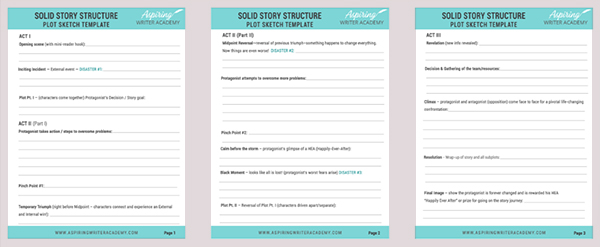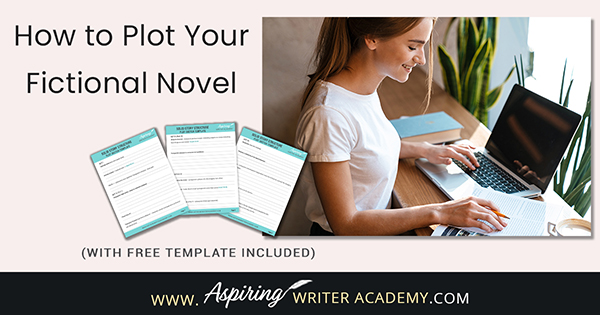Learn to Plot Fiction Writing Series: Story Analysis of the movie “Marry Me”
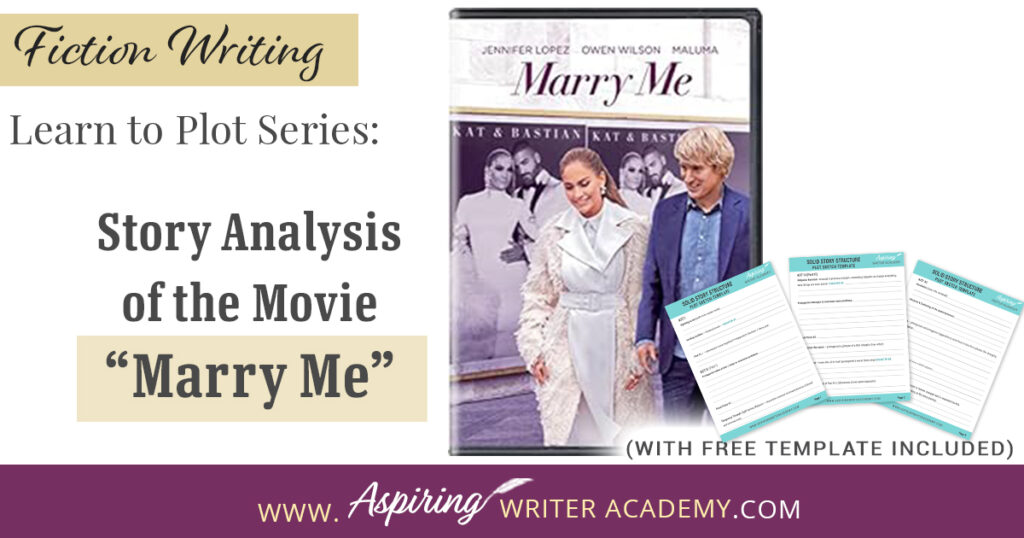
The best way to learn story structure is to analyze good stories. Can you readily identify each plot point in every movie you see or book you read? Or do terms like ‘inciting incident,’ ‘midpoint reversal,’ and ‘black moment’ leave you confused?
In our Learn to Plot Fiction Writing Series: Story Analysis of the movie “Marry Me” we show you how to recognize each element and provide a Free Plot Template so you can draft satisfying, high-quality stories of your own.
The movie, “Marry Me,” was released in March 2022, and stars: Jennifer Lopez, Owen Wilson, Maluma, John Bradley, Chloe Coleman.
Story premise:
A betrayed pop star (Jennifer Lopez), slated to marry her pop star fiancé (Maluma) on stage, instead marries a stranger from the audience – a high school math teacher (Owen Wilson). Against the odds, their sham relationship develops into something real…but can their love survive the limelight?
One of the best ways to learn story structure is to analyze as many movies and books as you can. We suggest you watch movies because you can see the whole story played out before you visually in approximately two hours, which may be quicker than reading an entire book.
We also suggest that you watch the movie with our Free Downloadable Solid Story Structure Plot Template beside you so that you can write down each plot point as soon as you see it appear on the screen. Do this twenty or so more times and you will soon be on your way to becoming a story structure expert!
Click to download our free Solid Story Structure Plot Sketch Template to help you analyze books or movies, and plot stories of your very own.
Warning! This post contains story spoilers. If you have not already seen the movie and do not want any story spoilers the first time around, you might want to watch the movie for enjoyment then watch it a second time using this post to help you identify each story element.

ACT I
Opening Scenes:
What do the opening scenes of “Marry Me” accomplish? How do they serve to set up the story?
- Setting.
First, you need to establish the ‘ordinary world. In the movie, “Marry Me,” we are introduced to the heroine, pop superstar Kat Valdez. She is in a studio with her team of dancers and the background radio announces she’s going to marry her fiancé (a music recording artist) live on stage the next day. Every news station is excitedly reporting on it. The intro to the story also shows her manager being interviewed and we see Kat’s promotion on billboards and hear the new hit song “Marry Me” which Kat and her fiancé Bastion, recorded together. These opening scenes with Kat and her entourage set up her ordinary world, her normal glitzy ‘always in the spotlight’ pop-star life. We are introduced to her dream / goal: to marry the love of her life.
- The first scene opens with an interesting situation (initial problem).
Now we have a few introductory scenes with the hero, Charlie, and his daughter, Lou. He is a single father and a math teacher at the school where his daughter is going to start attending. He is getting Lou’s lunch ready for school for her first day and he is worried how she will fit in. Lou is worried about her reputation and doesn’t want to be seen with her dad and have him embarrass her. She’s growing up and wants independence and Charlie worries he is losing his connection to her, especially since it appears her new stepfather is so cool. Charlie is worried that he is not ‘fun.’
- Introduction of the main characters, their personalities, and the character’s relationships with one another. Also hint at the internal (relationship) conflict and escalating external conflict.
Charlie is shown teaching his after-school math club and quotes his favorite line (a theme line of dialogue that keeps repeating throughout the story). “If you sit in the question, the answer will find you.”
Parker, the school counselor, a good friend of Charlie’s, and Pitts, the Glee Club director at the school are also introduced and will play prominent roles in the story later. These two tell Charlie that a new song, “Marry Me,” is being played everywhere, introducing him to Kat’s music.
When her date bails, Parker invites Charlie and his daughter, Lou, to go to Kat Valdez concert the following day. Charlie isn’t sure about going until Parker hits him at his weak point with Lou saying, “maybe she’ll think you are fun.” Of course, this ‘dig’ convinces Charlie to accept the invitation.
The main character’s goals / desires are set up:
Kat wants to marry the love of her life.
Charlie wants to be a fun dad and connect with his daughter, Lou.
Will these two get what they want? That is the implied story question and the reader/viewer keeps watching or reading to find out. The answer to these questions must be resolved for the reader by the end of the story.
Note: All of these ‘details’ are set up pieces that will show up again later and impact the story. Everything your character needs at the end should be set up in the beginning, so it is believable for the reader/viewer.
Ask-who are these characters and what will they need?
Inciting Incident:
After the opening scenes have introduced the characters and set up the genre, time period, location, hinted theme, and general pacing of the story, the protagonist is hit with the inciting incident, which rocks his (or her) ‘ordinary world’ and turns his life upside down. This serious problem cannot be ignored.
The protagonist must now decide how to deal with this serious problem, which becomes his new focus for the remainder of the story. The action plan to overcome this serious problem becomes the protagonist’s story-worthy goal.
In the movie, Marry Me, the Inciting Incident occurs when Kat sees a video on her cell phone that has gone viral. The video shows her fiancé Bastion kissing her assistant. This rocks Kat’s notion that Bastion is the love of her life, and she is devastated. However, there is no time to hide or even process what has happened because she is in her wedding dress, on stage, in the spotlight with thousands of people all watching, and expected to marry Bastion in the next few seconds.
Kat stops the music and asks to have the lights of the entire place lit so she can see the audience, whom she talks to from her heart about choices. As she questions love and her choices, she resolves to make new choices for a better outcome and her key thematic line is stated, “If you want something different, then you have to do something different.” She impulsively acts on this decision when she sees Charlie, holding a sign that says “Marry Me” in the audience and she says she will marry him instead of Bastion. Charlie, who was holding the sign for his friend, Parker, stumbles up on stage when encouraged by Parker and his own daughter, who are excited for him. Charlie thinks he is helping a woman out of an awkward, hurtful moment, and marries Kat on stage, infuriating Bastion, who says he’s sorry for cheating on Kat.
Note: The inciting incident is also referred to as the first major turning point to turn the story in a different direction or Disaster #1. What happens at the inciting incident is a game-changer.
If you are not familiar with the elements of solid story structure for popular fiction, you may want to see our post, How to Plot Your Fictional Novel, to help you further understand the specifics of what should be included in each section.
Plot Point I:
Plot Point I is the agreement between characters or decision the main character makes to accomplish a new story-worthy goal triggered by or in response to the inciting incident. This decision ends Act I. The main characters will unite to overcome the Inciting Incident problem.
In the movie, Marry Me, Kat discusses her options with her manager after the impromptu wedding fiasco on stage. Kat can either annul her marriage to a complete stranger or…stay married to Charlie until enough time has passed to end speculation that she was completely crazy. Although Charlie is skeptical of trying to make this sham marriage work, with the support of his daughter and friend, Parker, he agrees to stay married to Kat for 6 months if she will pay for a new math wing at his school.
‘Six months’ also starts a ticking clock or countdown for the reader which adds tension. Will they be able to keep this up for 6 months? What will happen after the 6 months is up? Will they really end the relationship or end up falling in love for real?
This is the new story-worthy question / goal for each of them. Kat and Charlie still have their personal goals, but this is the new external story goal that will drive the story forward.
The decision to go on the story journey often sends the characters through a doorway, or to a new location via a method of travel, or embark on an adventure, a different way of life. The start of the new adventure separates Act I and Act II.
Their lives will never be the same.

ACT II (Part I)
Now we journey into the main body of the story where the characters are learning to navigate their new ‘world / situation.’ The characters are learning, growing, being tested in their skills and in their relationships with one another. They are acquiring the know-how to face and deal with what is to come during the later segments of the story.
If the characters did not already transport to another location at the Inciting Incident, they may do so after the Plot Pt. I decision to go on the story journey. If the character does not actually travel, he may start a new job, or join a new group, or start to do something new, something that takes the character out of their comfort zone.
In Marry Me, the first action-step Kat and Charlie take is to hold a joint press conference to address their relationship. The reporters hound them, but Kat admits she and Charlie are just going to take their relationship one step at a time as they get to know one another, and Charlie offers the press a little history of marriage and charms them. This event helps Kat and Charlie gain mutual respect for one another.
Escalating events:
Reporters invade Charlie’s privacy at his home and at his school, something he is not used to, and he has trouble navigating his new world of ‘fame.’ He is also tech-challenged and is given a cell phone by Kat’s team to help him keep track of dates for public appearances.
Kat flies off to other concerts but continues to call Charlie to chat and get to know him.
Charlie’s daughter, Lou, thinks it’s cool he married Kat and wants to meet her, but he wants to keep Lou protected from the media. Charlie tells her the marriage is just for publicity, it’s not real.
Charlie is also not used to having his schedule changed and says he cannot make ‘The Today Show.’ However, his school counselor friend, Parker, helps move his schedule around.
Kat and Charlie’s second big action step is to do a publicity video of them bowling. Charlie attempts to teach Kat how to bowl but she surprises him with a strike, revealing she already knows how. Fans love the social media videos. And Kat skips a party to go home with Charlie and see his place and learn more about his life. She even dismisses her camera guy, and they share a little backstory on past heartbreaks. Charlie didn’t want to hold back his ex-wife from what she wanted, and Kat has had a string of brief marriages and is still trying to get it right.
Third action step: Charlie goes to the studio to hear Kat record her new song and decides to stay even longer, after his video obligation for the public is done.
Fourth action step: Charlie goes with Kat to a public Awards Gala where he is once again thrown into the spotlight. Bastion confronts Kat and she’s upset but Charlie cracks a joke that makes her smile.
Fifth actin step: Charlie confides to Kat in a phone call that Lou has agreed to join his math club and he’s thrilled because Lou is so good, but in her last math competition against another school, she froze up and she’s afraid it might happen again.
Kat was supposed to perform a private show for some big wigs but rescheduled so that she can come to Charlie’s math class and help the kids, including Lou, get over their fears by dancing while reciting math problems. Apparently moving their feet distracts them from their fear, allowing them to concentrate on the math problem. Kat admits she once froze up and blundered on stage, forgetting the words to a song, and she connects with Lou, which warms Charlie’s heart.
Kat is now starting to re-arrange her schedule for Charlie, and they are actively helping and sacrificing for each other, getting more involved in one another’s lives.
Kat and Lou get to know each other even more and when Kat can’t come up with the lyrics for the new music she wrote, Lou repeats her father’s key phrase: “When trying to solve a problem, if you sit in the question, the answer finds you.”
Pinch Point #1:
This emotional moment usually occurs about midway through the first half of Act II.
In Marry Me, Charlie tells Kat that she’s beautiful even without all the fame. Kat has reservations to go to Puerto Rico (where Bastion is) and Charlie says that if that is what she wants, then go. He reminds her if she goes back to Bastion, she’s making the same mistake of trusting the wrong guy all over again.
– The first pinch point serves to remind the main protagonist of all he could lose if he doesn’t attain his goal. Pinch Point #1 also motivates him to continue forward with renewed resolve. He will not give up!
Kat wants to marry for true love, and Bastion has already proved that he is not worthy.
Charlie is beginning to fall for Kat, and realizes he could lose her over different needs, the way he lost his first wife.
This moment reminds each of them why they are trying to make this marriage work and remotivates them to achieve the goal.
More escalating events:
Kat goes to the school dance with Charlie instead of going to Puerto Rico and she sings a song for the kids with her adoring fan, Pitts, the glee club director, playing guitar. Kat wants to dance but Charlie claims he’s not that good. They dance anyway and the night becomes a true date.
Temporary Triumph:
In most stories the characters experience an unexpected win in the external plot thread that triggers a celebratory win or triumph between the characters in the internal plot thread. In a romance, this is where the characters may share some backstory and kiss. It looks like the characters may be able to achieve their goal and will get their happily-ever-after. This is a moment of hope, that yes, the character can win.
Encouraged by their genuine connection at the school dance, Charlie and Kat go back to his place and listen to music and share more personal backstory. They are falling in love and sleep together. This changes everything because now at the midpoint, they are a real couple, and no longer acting. This escalates the stakes of the relationship because if they fail to make this marriage work, the consequences will not only be a blow to their public image but to their hearts.

ACT II (Part 2)
Midpoint Reversal
Bam! Just when everything seems fine and the goal within reach, an event happens at Midpoint, the second major plot point, to turn the story (and all the plot threads) in a different direction again. Disaster #2 changes everything and reverses the short-lived temporary triumph. In a relationship story, it changes the relationship.
In the fictional story, Marry Me, Charlie and Kat slept together which now changes their relationship. They will start doing things differently now.
While many of the lessons learned in the first half of Act I may have been more exploratory or reactive, the second half is stepping out to use and test those lessons proactively. The characters have now been enlightened as to what is really going on and they are going after what they want!
Escalating events:
Kat cancels her busy public schedule to spend the day alone with Charlie, out of the public eye.
Charlie challenges Kat that she must learn to do things on her own without her team to help her and in return, she insists he learn to get on social media and use it to connect with his math students.
Kat learns to make the drink smoothies that she publicly promotes. She also needs to break a window to get into her house when she can’t find the key and learns to operate the remote to control household features. Charlie’s class at school is helping him create social media profiles and post math memes with his cell phone.
The Calm Before the Storm:
This is a moment when the story takes a slight pause so the audience can catch their breath. This can be another moment of hope that all will be well, similar to the temporary triumph. The character may see or experience something to give them hope for the future or a reason to press on.
Kat takes him to Coney Island where she arranged for them to have the whole amusement park to themselves for his birthday, poignant because he had previously revealed to her that it was something he wanted to do with his mom before she passed, but it was closed.
Pinch Point #2:
About halfway through the second half of Act II, we have Pinch Point #2. Another moment to pull on the heartstrings. While Pinch Point #1 may have led the main character to see all they had to lose if they did not press forward with their goal, Pinch Point #2 leads them to see all they might gain. At the very least, both pinch points create a pause in the story which reminds the characters of the stakes and why their goal is important.
The second pinch point in Marry Me occurs when Bastion comes to find Kat at Charlie’s school, (invading Charlie’s home turf) and announces that the song Bastion and Kat recorded, “Marry Me,” has been nominated for a major award and they are scheduled to perform together at the award ceremony. While Charlie is happy for Kat, who seeks public credibility, he is jealous when she goes off to a party with Bastion to celebrate. He is afraid Kat will fall back in love with Bastion. Charlie fears he will be hurt when she does.
The Black Moment:
The black moment is the dark night of the soul, the bleakest moment, which is also the third major turning point, Game Changer, or Disaster #3. It appears that all hope is lost.
Kat and Bastion perform their song, “Marry Me,” at the awards ceremony, and they look so good together that Charlie’s daughter, Lou, urges him to get down there (or he is in real danger of losing Kat to Bastion.) The media is speculating the couple is reuniting.
Charlie greets Kat after the performance and tells her that she was amazing and that the public is speculating that she and Bastion are back together. He says their ruse of a marriage worked – they saved her public image. No one even remembers the wedding fiasco. Charlie realizes their lives are very different. He doesn’t think a real relationship will work between them and Kat is upset when he breaks up with her. It’s clear that Bastion wants her back and Charlie leaves, to protect himself from heartache.
Plot Point II:
Plot Point II follows quickly on the heels of the Black Moment. This is when the characters separate or are driven apart due to the events of the Black Moment. The protagonist finds himself alone, struggling with what to do next.
At this point in Marry Me, it’s clear that Bastion wants Kat back and Charlie leaves, to protect himself from heartache. Charlie and Kat separate.
At Plot Pt. II the characters are driven apart. (This is a reversal of Plot Pt. I where the characters came together.)

ACT III
Revelation:
Then, suddenly the protagonist gets a new piece of information that changes the situation, and the characters can see how they might succeed in their battle against the external antagonist which they must face.
Kat’s manager reveals to Charlie that Kat and Bastion are not really together, it’s just a ruse for the public. (Just as Kat’s marriage to Charlie had been.) The manager confides that he had been rooting for Charlie and is sorry for how things turned out. He gives Charlie a check for his efforts just as they agreed at Plot Pt. I and Charlie doesn’t want it but takes the money for the kids at his school.
Kat comes up with the words to her new music, a song titled, “On My Way.” She attends events alone while her new song rises on the music charts. She is on live TV with Bastion on the Jimmy Fallon talk show and when it is suggested that she and Bastion wrote songs for each other, Kat suddenly realizes that she didn’t write “On My Way” for Bastion.
Before the show she saw Bastion make an intimate gesture toward her new assistant, showing he hadn’t changed. She wrote the song when heartbroken that Charlie left, and she now knows she doesn’t want to go back to Bastion, she wants Charlie. She repeats Charlie’s key phrase, “If you sit in the question, the answer finds you.”
Decision:
The revelation (new information revealed) helps the protagonist to make a decision.
Kat realizes that she didn’t write the song for Bastion and that she doesn’t want to go backwards in her life but forward with a life with Charlie. She makes the decision to go after him.
Re-gathering of the Team or Resources:
Whatever people, tools, items are going to be needed for the climax are gathered together. If the protagonist’s team was separated at Plot Pt. II, this is when they come back together, realizing they need one another.
In Marry Me, Kat uses all her resources and connections with different people she has met along the way in this story journey to help her board a plane, then a bus, to get to the big Math-a-lon competition where Charlie’s class is competing against students from other schools. Her manager, Charlie’s school counselor, Parker, and the Glee club director all help her. Kat also needed to use her own skills to get a winter coat and get to the competition in time.
Climax:
This is the most exciting scene sequence in the entire book or movie. This is a face-to-face confrontation between the protagonist (and his team) and the opposition. Either the protagonist succeeds once and for all or he fails. Everything is put on the line. It will not be easy.
At the math competition, the kids of the team opposing Charlie’s class laugh at Lou and expect her to freeze up and choke again like she did the year before. There are two teams left in a sudden death “showdown.” Lou is full of confidence until she sees a kid ‘choke’ and reminds her of past failures. Her fears return and it looks like she’ll succumb to her previous behavior and choke like she did before, but then she sees her father move his feet and start dancing to remind her of Kat’s solution to her problem.
Lou shifts her feet into dance steps while she considers the answer to the math problem. And Kat runs into the room in time to see Charlie urging his daughter to do the dance steps that she taught his class, which is heartwarming.
The dance steps help, and Lou gets the right answer but not in time before the buzzer ends the competition. The opposing team wins but Charlie is so proud of Lou for stepping out in spite of fear and giving the correct answer. Kat is proud of her too. Lou took a shot even though she was scared and that is all that matters. (The writers could have had Lou win, but by having her lose the competition but win in her personal endeavors is more satisfying and realistic.)
Kat wants another shot with Charlie and holds up a sign like he did at the beginning of the movie that says, “Marry Me” and another sign that reads, “Again.” This repetitive action frames the story like bookends, bringing it full circle. Often, a story’s end is found in its beginning.
With the future of their relationship on the line, Charlie goes to her, and they kiss.
Resolution:
This is where the main storyline and all sub-plots are wrapped up with their reaction to what transpired at the Climax. The story journey has changed the protagonist. He/she can do things that they couldn’t do in the beginning. But the protagonist must do something to prove he’s changed. Show it.
The conflicts in both the external plot layer and the internal relationship plot layers have been faced and defeated. They have ‘won!’
In this fictional story, Kat was able to walk away from a bad relationship and use her own resources to get what she wanted-something she couldn’t do at the beginning.
And Charlie has stepped out to embrace changes in his life that might leave him vulnerable. His daughter, Lou, has done the same.
Final Image:
This is the very last image or scene of the entire story, a ‘capping off’ scene.
At the end of the movie when Kat and Charlie kiss, we are left with the impression that this happy couple will finally get their ‘happily-ever-after’ and have a happy marriage.
Kat wanted to marry the love of her life.
Charlie wanted to be a fun dad and form a better connection with his daughter.
Kat helped him with that father-daughter connection, and he helped Kat find true love without all the fame and help from others. They are better people now because of the story journey and their love for one another.
The final images in Marry Me show many of the sub-characters revealing how Charlie and Kat’s relationship inspired them to spontaneously meet the love of their lives. Everyone is now stepping out to find true love in places they hadn’t expected before-which leaves the reader / viewer also feeling optimistic about finding love.
This strengthens the themes:
If you want something different, then you have to do something different.
Having the courage to take a shot even if you are scared, is all that matters.
If you sit with a problem long enough, the answer will find you. (The answer will come.)
Is there a thematic question asked in your story or is it only hinted at?
A story may have one main theme and several other sub-themes. The subplots can all reflect different aspects of the main theme or sub-themes. The theme should come through the character’s story journey. Each reader may see a different theme when reading your story. In fact, they may see a theme that they relate to that you hadn’t even intended. Stories mean different things to different people. What themes can YOU extract from Marry Me? How does this story speak to you?
Does the ending of your story lead the audience to ponder a life question? Or does it reinforce a value deemed as important to society? What is the unspoken message your story has to say?
Additional Thoughts:
How does this story structure line up with your own writing? Have you included all the steps or are you missing some?
Bottom of FormWe hope you have enjoyed our Learn to Plot Fiction Writing Series: Story Analysis of the movie “Marry Me” and have downloaded the Free Solid Story Structure Plot Template to analyze more books and movies, or perhaps to outline a story of your own.
If you like more help developing your story, you may wish to download our Free Brainstorming Your Story Idea Worksheet
How to Create Antagonists & Villains Workbook
Do you find it difficult to create compelling antagonists and villains for your stories? Do your villains feel cartoonish and unbelievable? Do they lack motivation or a specific game plan? Discover the secrets to crafting villains that will stick with your readers long after they finish your story, with our How to Create Antagonists & Villains Workbook.
This 32-page instructional workbook is packed with valuable fill-in-the-blank templates and practical advice to help you create memorable and effective antagonists and villains. Whether you’re a seasoned writer or just starting out, this workbook will take your writing to the next level.

Our Goal for Aspiring Writer Academy is to help people learn how to write quality fiction, teach them to publish and promote their work, and to give them the necessary tools to pursue a writing career.

ENTER YOUR EMAIL BELOW
TO GET YOUR FREE
“Brainstorming Your Story Idea Worksheet”
7 easy fill-in-the-blank pages,
+ 2 bonus pages filled with additional story examples.
A valuable tool to develop story plots again and again.
Other Blog Posts You May Like
Learn to Plot Fiction Writing Series: Story Analysis of the movie “The Greatest Showman”
Learn to Plot Fiction Writing Series: Story Analysis of the movie “Jumanji: Welcome to the Jungle”
Learn to Plot Fiction Writing Series: Story Analysis of the Disney movie “Frozen”
Learn To Plot Fiction Writing Series: Story Analysis of the Movie “Top Gun: Maverick”
Learn to Plot Fiction Writing Series: Story Analysis of the movie “Signs”
Fiction Writing: Story Analysis of the movie “Passengers”
Learn to Plot Fiction Writing Series: Story Analysis of “Beauty and the Beast”
How to Plot Your Fictional Novel (with Free Template Included)
How to Write Act I: Opening Scenes for Your Fictional Story
Structuring Act II (Part 1) for Maximum Impact: How to Keep Readers Engaged
Structuring Act II (Part 2) for Maximum Impact: How to Keep Readers Engaged
How to Write Act III and Finish Your Fictional Story in 5 Steps

is a multi-published author, speaker, and writing coach. She writes sweet contemporary, inspirational, and historical romance and loves teaching aspiring writers how to write quality fiction. Read her inspiring story of how she published her first book and launched a successful writing career.


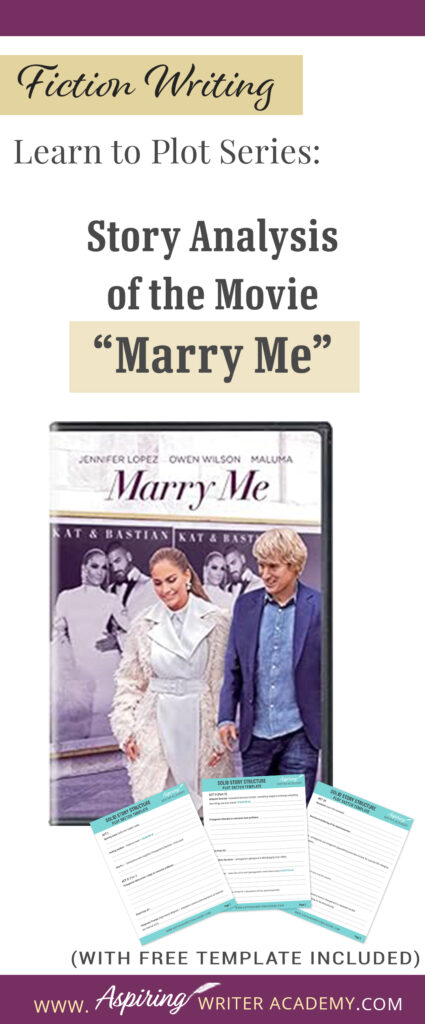
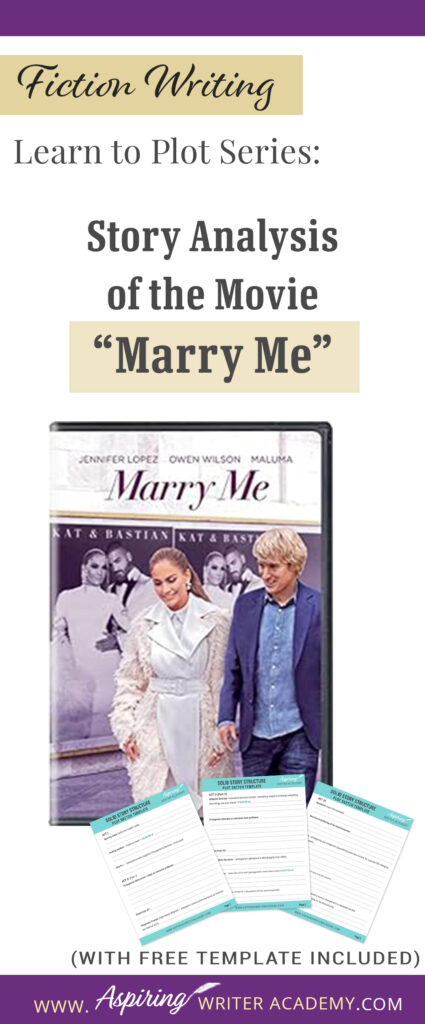
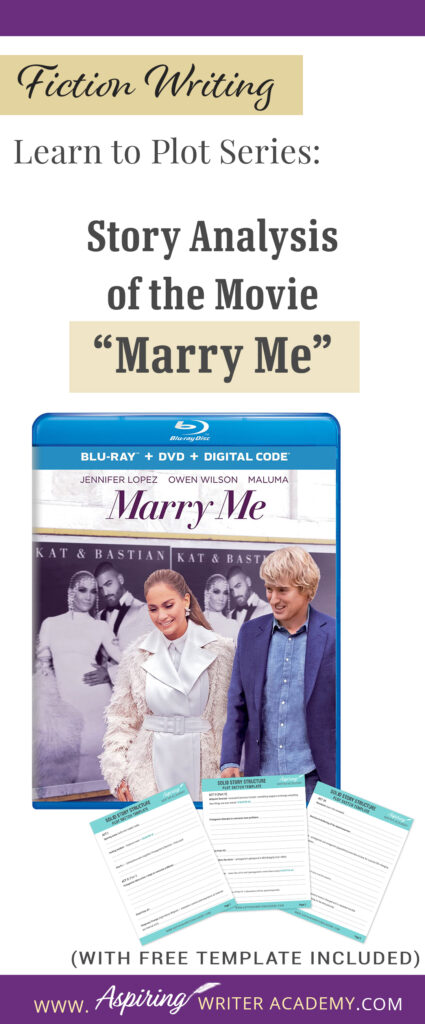
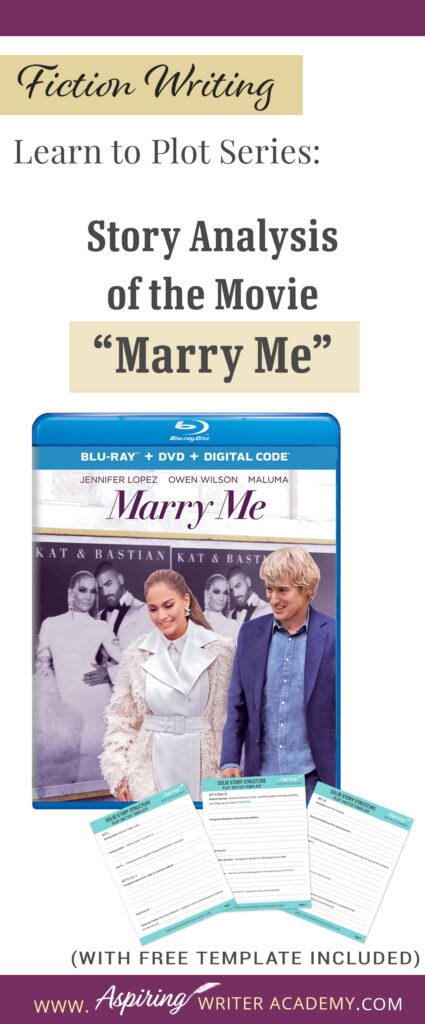
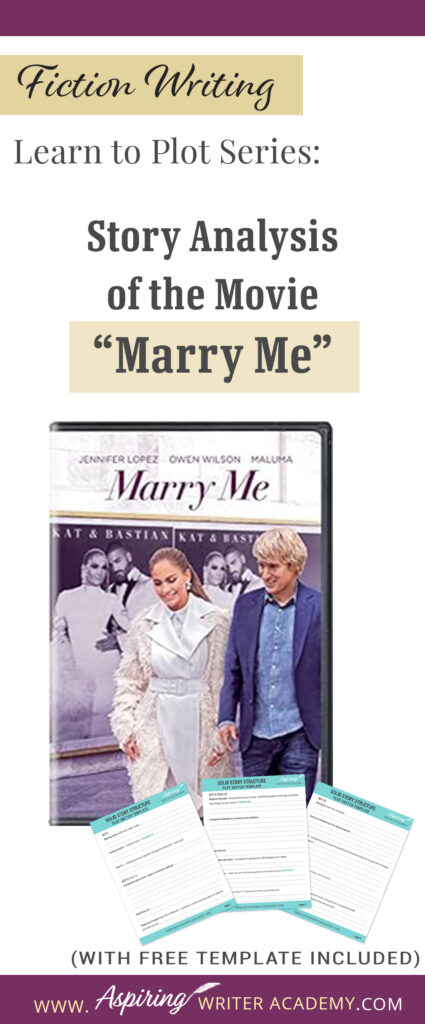
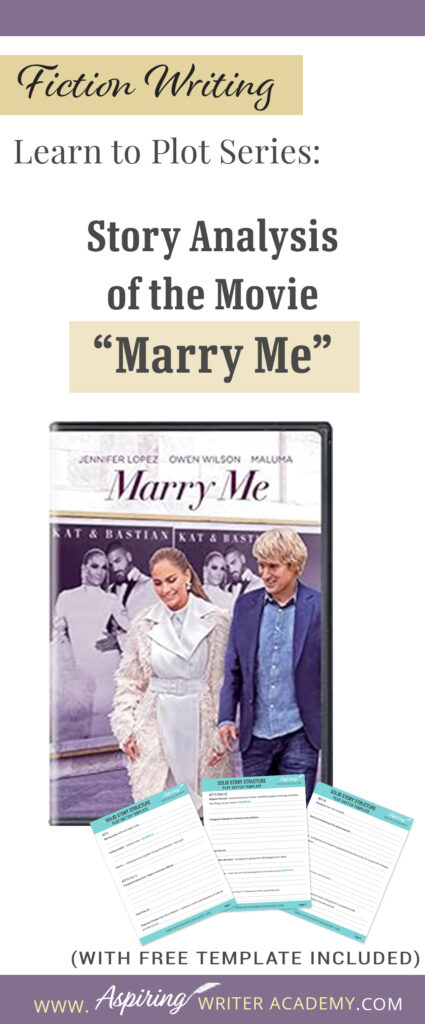
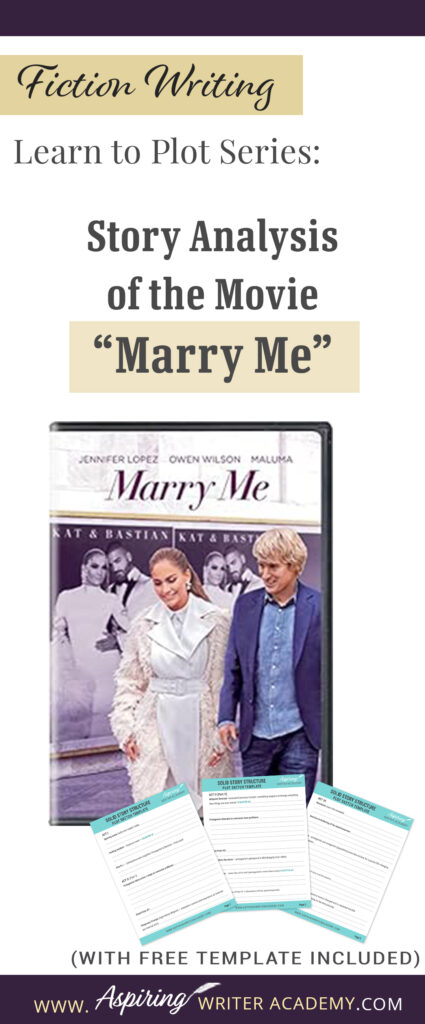
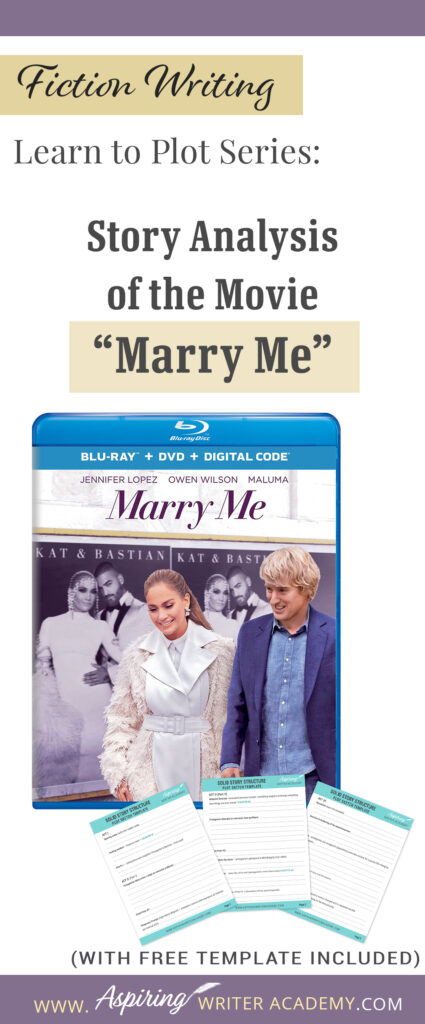
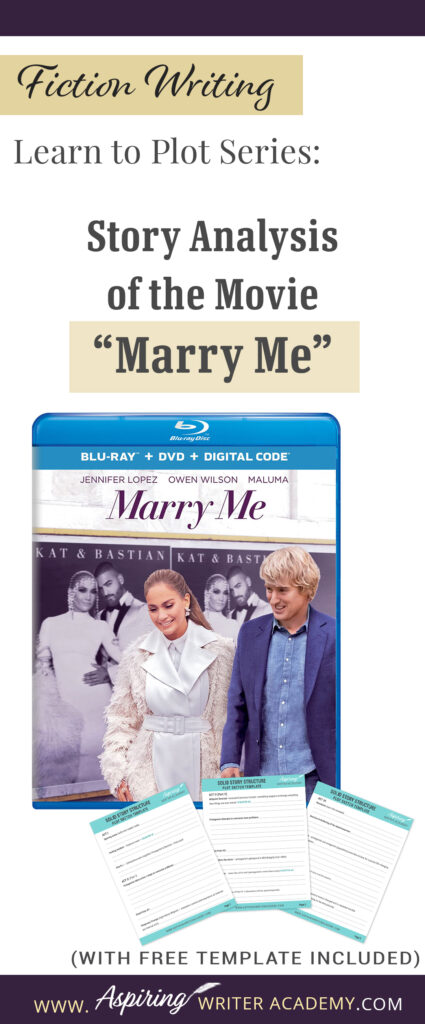
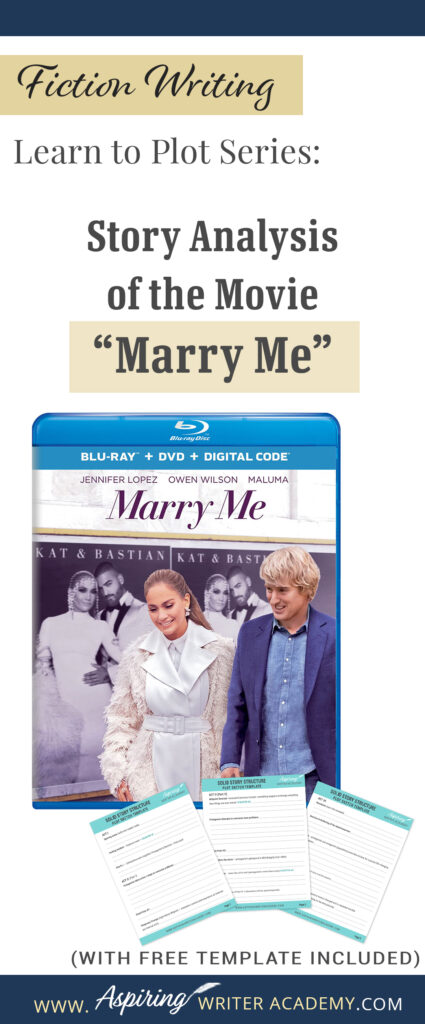
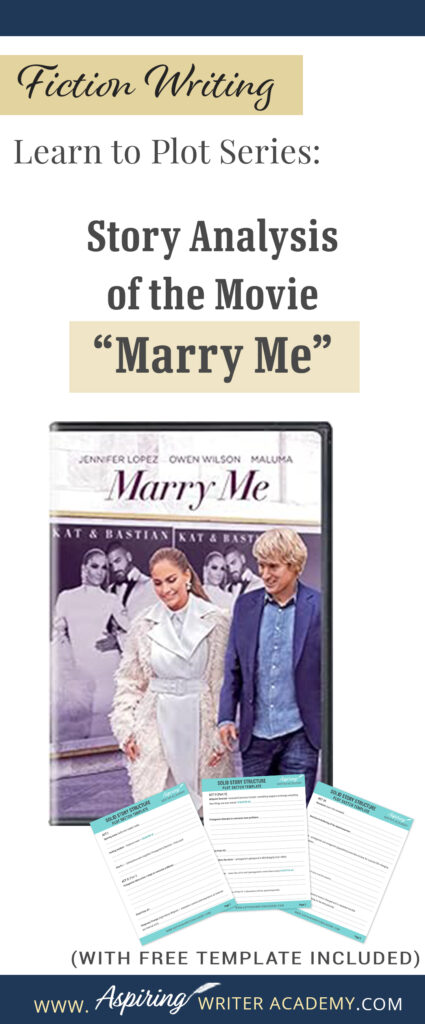
![Marry Me [DVD]](https://m.media-amazon.com/images/I/51b+2RwtuGL._SL500_.jpg)
